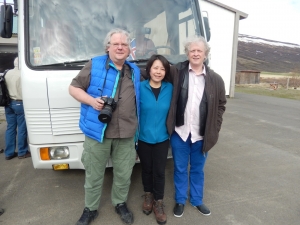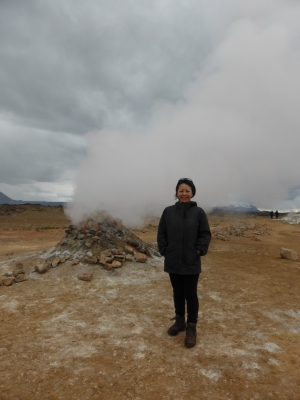This project, titled “Literary Studies of Climate Change Issues and Research on Environmental Humanities,” is a part of the ongoing research on Environmental Humanities that I launched on my year-long sabbatical leave which started in October 2014. Environmental Humanities is an interdisciplinary arena in which many different disciplines including environmental history, ecocriticism (literary studies), anthropology, archaeology, and philosophy work in a cooperative way to research and discuss issues of the environment. I conducted some preliminary researches on Environmental Humanities in Sweden in October and December 2014; one of the highlights during those research stays was my participation in an international symposium on Environmental Humanities, which was held at Mid Sweden University in December 2014. At the symposium, I not only learned theoretical and practical possibilities of this field but also was acquainted with leading scholars including Þorvarður Árnason at University of Iceland. Professor Árnason is one of the central figures of the Nordic Network of Interdisciplinary Environmental Studies (NIES) and informed me of a NIES-hosted intensive summer course on Environmental Humanities which was held in North Iceland in summer 2014. A similar course was about to be announced for the summer 2015, and it seemed an ideal occasion for me to deepen and expand my understanding of this field. Thanks to support from the Watanabe Trust Fund and the Scandinavia Japan Sasakawa Foundation, I was able to go to Iceland to participate in the intensive course which was held from June 5th through 15th, as well as doing some related research on literary approaches to climate change issues before the course started.
What follows is a snapshot of my visit to and three-week stay in Iceland. On May 29th, on my way from Charles de Gaulle to Keflavik, I was fascinated by the fact that the sky was getting brighter as midnight approached. Theoretically I knew about mid-night summer, yet physically my first experience of non-dark midnight made me realize some of the uniqueness of the North. Taking a fully-packed airport shuttle to a city bus terminal in Reykjavik, I met Viðar Hreinsson, a known independent scholar of Icelandic and world literature, who kindly gave me not only a ride to my hotel but also a city tour (it was past 1 am but not dark, so a city tour en route perfectly made sense!). Mr. Hreinsson is a key organizer of the intensive course on Environmental Humanities and his academic knowledge, practical support and advice, friendly help, and great sense of humor made my research stay fruitful and meaningful.
During the first week (May 30th through June 4th) I mainly worked on research at the University of Iceland’s library, examining the literary approaches to issues of climate change, energy, economy, and politics in Andri Magnason’s work. I also met Mr. Hafliði Sævarsson, Project Manager at the University of Iceland’s International Office; Mr. Sævarsson took care of practical matters including finding affordable lodging for me and taking me to a bank, which helped my days in Reykjavik go smoothly. I spent some time at the National Museum of Iceland as well, which helped me familiarize myself with the history, culture, and geology of the country with its wide-ranging, in-depth exhibitions.
From June 5th through 15th, I participated in the intensive course, which is officially known as the Svartarkot Culture Nature Summer Course titled “Understanding the Human Dimensions of Long-term Environmental Change: Transformations of Iceland from the Viking Era through the late Medieval Period (CE 850-1500),” supported by NIES and the North Atlantic Biocultural Organization (NABO). The course was held at the Kidagil Guesthouse in the sheep-farm dotted Bárðardalur Valley of Northern Iceland. Right before the beginning of a busy tourist season, the guesthouse was for our use only and all the participants including lecturers stayed there (our group was initially about fifteen but the number increased towards the end due to a different yet related group’s joining us), having meals together in the dining hall, going out for night hikes together, and enjoying conversation till late at night. Every day we had an 8:30 AM to 6:00 PM boot-camp-like schedule with lectures, discussions, and occasional fieldtrips to places which have preserved their cultural memories in the form of craftsmanship, architecture, and everyday life. The course focused on literary legacy—Icelandic Saga in particular—and moved towards more interdisciplinary discussions on medieval cultures and the environment of Iceland. The following is the Day 2 schedule from our course syllabus:
Saturday, June 6th
7:30-8:30 Breakfast at Kiðagil
8:30-10:30 Introduction and Background (Steven Hartman and Reinhard Hennig): The course in the context of the IEM Project and discussion of integrated transdisciplinary study of saga literature, archaeology, and environmental history (Steve), plus Historical and Literary context of medieval Icelandic sagas and value as sources of environmental data and environmental memory (Reinhard).
10:30-11:00 Coffee Break and Discussion time
11:00-12:00 Archaeology and Material Culture -- Discussion of Milek article on gendered spaces (Tom McGovern)
12:00-1:00 Lunch at Kiðagil
1:00-3:00 Panel discussion (Vidar Hreinsson, Mike Twomey, Hartman, Hennig) on Grettir’s Saga and related works.
3:00-3:30 Coffee Break
3:30-6:00 Hiking to Grettir’s Sword (Hreinsson)
6:00-7:00 Dinner at Kiðagil
7:00-8:00 Archaeology of Bardardalur and the Highlands (McGovern)
The seminar targeted graduate students. Participating in the seminar as a senior scholar/observer, I learned how intergenerational and interdisciplinary scholarly network can be built.
Back to Reykjavik, I was fortunate to have an occasion to meet writer and environmental activist Andri Magnason in person to talk with him on his work and issues of literary approaches to the environment. Three weeks went fast yet with lots of new thoughts, inspiration, insights, and fond memories. Last but not least, I would like to express my deepest gratitude to the Watanabe Trust Fund for making this research stay in Iceland possible.
Yuki Masami
Professor, Kanazawa University
気候変動問題への文学的アプローチの研究およびアイスランドの環境人文学に関する調査
結城正美 金沢大学教授
私はエコクリティシズムを専門領域とし、これまで北米、東アジア、北欧を主なフィールドとして環境問題を文学的観点から研究してきました。本プロジェクトは、渡辺信託基金とスカンジナビア・ニッポン ササカワ財団の支援を受け、アイスランドをフィールドとする環境人文学の研究に取り組むものです。三週間の滞在期間中、具体的に二つの課題に従事しました。ひとつは気候変動をめぐる文学研究、もうひとつは環境人文学の理論的・実践的研究です。アイスランドは近年関心が高まっている地熱発電への取り組みで知られ、気候変動のなかでもとりわけエネルギー問題と関連した文学作品の存在が際立っています。また、首都レイキャヴィークがユネスコ文学都市に認定されている事実に象徴されるように、アイスランドにはサーガをはじめとする独自の文学的伝統があります。そうした重厚な文学的営みと歴史や考古学の関心が交わる地点で、とりわけアイスランドの自然・文化環境に着目するかたちで学際的研究を進める「環境人文学」が近年発展しており、ちょうど北部アイスランドで環境人文学の集中セミナーが開かれる時期にあわせて本プロジェクトのスケジュールを組みました。
2015年5月29日、午後11時30分過ぎにケプラヴィーク国際空港に到着。経由地のパリからアイスランドに向かう機内で、時間は確実に夜中へと進んでいる一方で空が明るくなっていく様子を目にしながら、日が沈まない北の地へ向かっていることを実感しました。空港から直行バスでレイキャヴィーク市内へ向かい、バスターミナルで下車すると、電子メールで打ち合わせたとおりレイキャヴィークアカデミーのViðar Hreinsson氏が迎えにきてくれていました(初対面でしたがSNSをとおして写真をみていたので迷うことなく互いに気づきました)。夜中の1時過ぎ、白夜の薄明のなか車で市内案内を受けながらホテルへ送っていただきました。Hreinsson氏の気さくで配慮に満ちた歓待は、初めてこの地を訪れる私の緊張をほぐしてくれ、大変ありがたかったです。
翌30日から6月4日まで、アイスランド大学図書館や国立アイスランド博物館で、アイスランドの文化、環境、文学に関する研究調査をおこないました。その間、渡辺信託基金担当者のHafliði Sævarsson氏(アイスランド大学国際課)には実務面で助けていただき、スムーズに日常生活を送ることができました。レイキャヴィーク滞在はほんの一週間余りでしたが、Hreinsson氏とSævarsson氏の二人から勧められたAndri Magnasonの文学実践に注目し、エネルギー、環境、経済の問題への文学的アプローチについて検討しました。Magnasonの著書 Dreamlandに触発されて訪れた地熱発電所では、環境への負荷が小さく「クリーン」だとみなされている地熱エネルギーの表象と実態の乖離について大いに考えさせられました。
6月5日からは、本プロジェクトのハイライトである環境人文学集中セミナーに参加するため、北部のキダギルへ。大学院生対象の集中セミナーだけあって朝から晩まで講義やフィールドワークでタイトなスケジュールでしたが、ハイランドの壮大な自然のなかでの10日間は加速化する都市文明を相対的に考える上で最適な場所でした。セミナーの主なテーマは中世アイスランドの土地の記憶です。環境問題への取り組みには現代の状況を相対的にとらえることが不可欠ですが、その足場として過去に着目することの意味は小さくありません。アイスランド北部の過去――土地の記憶――を、歴史、文学、考古学等さまざまな学問分野から相互関連的に検討し、また実際にその土地をフィールドワークすることにより、過去の記憶に多角的に接近することを目指したセミナーでした。これはHreinsson氏を中心として企画されたもので、アイスランド、スウェーデン、米国、英国などの研究者を講師とし、専門分野だけでなく文化や世代も横断するダイナミックな学術環境を目指しており、運営面で学ぶことも多かったです。本研究助成を申請段階からサポートしてくれたアイスランド大学のÞorvarður Árnason氏も視覚的環境表象の講義を担当され、セミナー期間中に個人的にも、彼が主にフィールドとしている氷河ならびに気候変動の話を聞くことができました。
6月15日にキダギルを発ち、往路同様、文学的・歴史的・考古学的に興味深い場所の説明を受けながらレイキャヴィークへ。16日は作家Andri Magnason氏と歓談する機会に恵まれました。Sævarsson、Hreinsson両氏に紹介していただいて実現したのですが、研究対象としている作品の書き手本人に会えるとは思っていなかったので、うれしい驚きでした。その後、アイスランド大学でSævarsson氏にキダギルでのセミナーについて報告し、大学図書館で最後の資料整理に取り組み、17日午前の便で帰国の途に着きました。
本プロジェクトでは、アイスランドに実際に来なければ気づかなかったであろう環境言説の複雑さや危うさ、そして草の根的な取り組みの力強さを目の当たりにし、またセミナー参加をとおして多くの研究者と交流を深めることができ、実に有意義でした。最後になりましたが、本プロジェクトへの渡辺信託基金の支援に心から謝意を表します。




